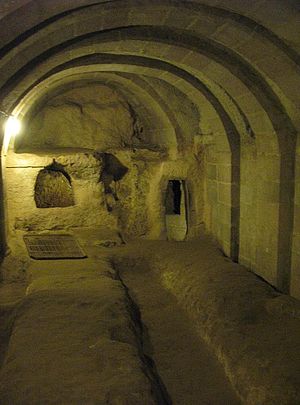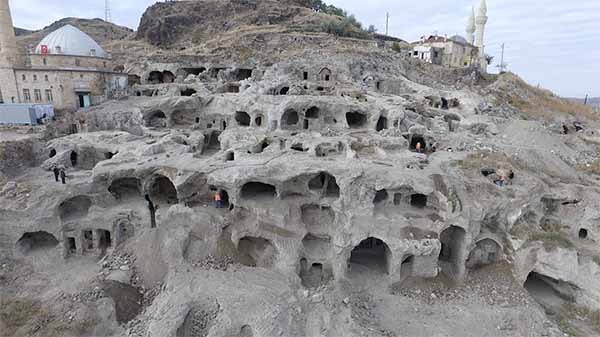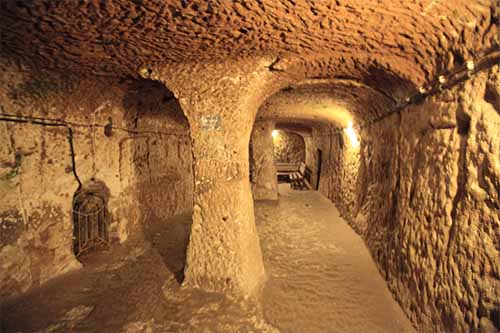Secret Hidden Turkish Underground City: Derinkuyu & Kaymakli

Many cities, such as Petra which almost completely merges into the surrounding cliffs, were built in unusual places. In Turkey, for example, cities that are completely underground have recently been discovered.
Derinkuyu discovery
In 1963, Omer Demir discovered, almost by chance, some 30 kilometers south of Nevsehir, in Turkey, a “deep hole”: in Turkish, Derinkuyu. It is said that his attention was drawn to a hen that had suddenly disappeared through a crack inside the earth. Omer Demir began to dig and then discovered a very steep gallery which led underground. Equipped with a flashlight, he entered it and found steps, narrow passages, niches cut in the rock and ventilation shafts. Although over time some passages have been filled or closed in one way or another, it soon became clear that this was not just a simple underground cavity.

In fact, intense archaeological excavations made it possible to discover that the “deep hole” was in reality a real city, laid out underground. This underground city was spread over several levels - we discovered other wells and other galleries, deeper -, some of which could be closed using a round stone, as big as a millstone. We then imagined that Derinkuyu was a place of refuge. But as the research progressed, we realized that the site was too important for that. In addition to places of residence, numerous excavations revealed warehouses, wine cellars, shops but also gigantic rooms with vaulted ceilings, which were undoubtedly used for teaching. The city also had an underground church, 65 meters long, as well as other isolated spaces, probably stables. In total, the underground city of Derinkuyu now covers 4 square kilometers.
Thirteen levels were found, the deepest of which is 85 meters underground, but there are probably others. It is estimated that more than 20,000 people could stay there quite comfortably. The location and construction of hidden passageways, ventilation shafts, the width of the galleries, everything is so well thought out that it does not seem to be a temporary solution, fitted out in an emergency. However, the layout of the galleries, which may be closed, as well as certain common rooms or the ventilation system which could also be used to communicate nevertheless suggests that the men of Derinkuyu lived in fear of persecution.
A unique city ?

Derinkuyu's sensational discovery prompted archaeologists to search for other underground cities in Cappadocia. Thirty cities of this type have already been identified, and it is believed that there are many others. Indeed, some galleries discovered in this area seem to give access to other cities. But most of these sites are now filled and inaccessible. Derinkuyu, Kaymakli - which is 6 kilometers north of Derinkuyu - and Ozkonak are the three best preserved sites. Some galleries or rooms in these extraordinary underground cities have even been opened to the public, notably in Kaymakli where you can visit the stables, the church or even the kitchens. But Cappadocia does not have the prerogative of underground cities. A little everywhere, various indices suggest the existence of underground cities. It is estimated today that there are or there have been between three hundred and five hundred around the world.
When did the underground city of Derinkuyu date ?

The presence of a church and a basin thought to be designed as a baptismal font led archaeologists to believe that the people of Derinkuyu were being persecuted because of their Christian faith.
Other theories, later challenged, however emerged. The idea, for example, that men might have sought refuge in these galleries during war or to protect themselves from possible lava flows came up against the following argument: in both cases, the chimneys of ventilation would have been a weak point since, filled by the enemy or invaded by lava, they would certainly have resulted in the death of the populations who would have taken refuge there. What is more, other churches were later discovered in other parts of the city, which is further evidence in favor of the first theory.
It is admitted today that the underground cities appeared some 3,000 years ago, at the time of the Phrygians, without it being possible to say, however, if these people are at the origin of the underground developments. On the contrary, certain indications seem to point out that they were the work of the Hittites, an Indo-European people who had formed a powerful empire in Anatolia between the 17th and 12th centuries BC. While we have been able to detect in the neighboring cities of Bogazkoy and Alacahoyuk traces of fire attributable to the Phrygians, no trace of this species has been found in Derinkuyu. It is therefore quite possible that the Hittites withdrew to the already existing galleries to flee the Phrygians. In the eyes of certain authors, the absence of traces of the Phrygians at Derinkuyu is proof that the method was effective. The city then fell into the hands of the Byzantines, who enlarged it, until the Arabs and the Sassanids invaded the region in their turn in the 6th century AD and attacked the city several times. Thereafter, Derinkuyu lost all its importance.
However, this theory does not explain the presence of Christian churches in these underground spaces, since neither the Phrygians nor the Hittites claimed to be of Christianity. Some believe that the churches were built much later. This possibility is not to be excluded, but seems unlikely given the layout of the corridors around the churches.
Sand in the galleries and oxen in the meadows
If Derinkuyu and many other underground cities in the region could go unnoticed for a long time, it seems that part of the wells and galleries was voluntarily filled with sand and stones after the city been abandoned. If no one knows the reason for this abandonment, since no account remains of this period, it must nevertheless be assumed that such work on such an important complex could only be undertaken in times of peace.
For some, the city was abandoned and filled in order to allow the construction of a new city on the surface of the earth, on firm ground and without risk of collapse. This idea is conceivable since the inhabitants who sought to survive underground still remained dependent on certain terrestrial activities, as evidenced by the presence of underground stables. Although the oxen could be kept underground, they still had to be grazed on the surface. But this consideration again raises the question of the usefulness of underground cities: why did a people bother to develop an entire city underground?
The underground cities of Cappadocia continue to harbor many puzzles. What event motivated their development? Who built them? By what means have they been able to dig such galleries over almost twenty floors and remove the spoil?
The Hittites
The Hittites, according to the current state of our knowledge, were a Caucasian people, arrived in the third millennium BC in Anatolia, the Asian part of present-day Turkey, where they would have mixed with the Hattis. For reasons still unexplained, the Hittites then managed to take control of the country and founded a huge kingdom that even included part of present-day Syria. For almost a millennium, they ensured a power comparable to that of the Egyptians and Babylonians.
At the beginning of the 12th century BC, after the fire and the sacking of most of the cities, the Hittite empire disappeared. For a few centuries more, some tribes persisted in the southern and eastern parts of the old empire, then all traces of them were lost. These groups no doubt ended up falling under Assyrian domination.









































































































































































































































































































































